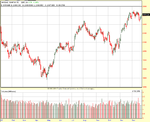Hi everyone,
I've done a bit of backtesting on various systems and found that almost any long signal generated by ma, rsi, stoch etc seem to work best when the overall market is in bull mode.
When the market is in bear mode or choppy, the same signals tend to lose or show a very tiny profit.
When systems seem to be so dependent on overall market direction, how do you trade in a bear/choppy market? Or do you only trade when the market is in a bull phase?
I've done a bit of backtesting on various systems and found that almost any long signal generated by ma, rsi, stoch etc seem to work best when the overall market is in bull mode.
When the market is in bear mode or choppy, the same signals tend to lose or show a very tiny profit.
When systems seem to be so dependent on overall market direction, how do you trade in a bear/choppy market? Or do you only trade when the market is in a bull phase?

